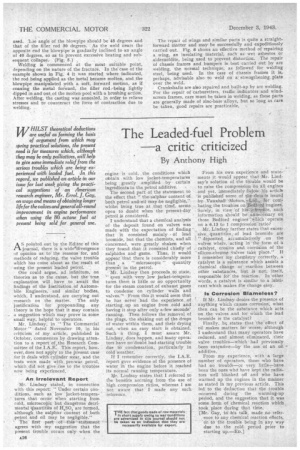The Leaded-fuel Problem a critic criticized
Page 28

If you've noticed an error in this article please click here to report it so we can fix it.
By Anthony High
AS poinled out by the Editor of this
• journal, there is a widedivergence of opinion as to the reasons for, and methods of reducing. the valve trouble which has come about as the result of using the present leaded petrol.
One could argue, ad infinitum, on theories as to the cause, but the true explanation will, have to await the findings of the Institution, of Automobile Engineers, and similar bodies, which, I understand, are carrying out _research on the matter. • The only justification for propounding any theory is the hope that it may contain a suggestion which may prove in some small way, helpful to operators.
Mr. Lindsay, in "The Commercial Motor" dated November 10, in his criticism of my article, published in October, commences by drawing attention to a report of.the Research Committee of the I.A.E. This report, however, does not apply to the Present case for it deals with cylinder wear, and the tests were made with pre-war petrol, which did not give rise to the troubles now being experienced.
An Irrelevant Report
Mr. Lindsay stated, in connection with this -report: " Under certain conditions, such as low jacket-temperatures that occur when starting from cold, microscopic but dangerous detrimental quantities of HSO4 are formed, although the sulphur content of .both petrol and oil may be negligible."
• The first partof this statement agrees with my suggestion that the present trouble occurs only when the engine 'is cold, the conditions which obtain with low jacket-temperatures being . greatly amplified by certain ingredients in the petrol additive. ,
The second part of the statement to the effect that " the sulphur content of both petrol and oil may be negligible," whilst being true at that time, seemsopen to doubt when the present-day petrol is considered.
I understand that a cheniical analysis of the deposit found on valves was made with the expectation of finding that it consisted mainly • of lead bromide, but that the chemists, and all concerned, were .greatly shaken when they found that it consisted chiefly of sulphides and gums. Thus, it would appear 'that there is considerably more than a "microscopic " quantity present in. the petrol. • Mr. Lindsay then proceeds to state,
eyen with very low jacket-temperatures there is little or no opportunity for the steam content _of exhaust gases to condense on 'cylinder walls and valves." From this it would seem that he has never had the experience of starting up an engine from cold and having it stop after only a few seconds' running. Then follows the removal of the plugs, the shaking out of the drops of water within 'them, and their drying out, when an easy start is obtained. Such a thing, I must assure Mr. Lindsay, does happen, and tnany operators have no'doubt had starting trouble due to condensation, particularly in cold weather.
If I remember correctly, the I.A.E. report gave evidence of the presence of water in the engine before it reached its normal running temperature. '
Vr. Lindsay states that I referred to the benefits accruing from the use of high compression ratios, whereas I am not aware that I made any such reference.
From his own experience and statements it would appear that Mr. Lindsay's solution of the trouble would be to raise the compression On all engines and yet, immediately below his article is published some of the details issued by Vauxhall .Motors,?-1.,.td.e. for cori. bating, the troubles on-1340cl engineS. Surely, in view of hi.inteteee, such
• information should be unnecessary on those Bedford engineS'.'Which operate on a 6.13 to 1 compression ratio?
' Mr, Lindsay further states that excessive quantities, of lead bromide are " deposited, accumulatively on the , valves where, acting in the form of a catalyst, erosion and corrosion of the silicon-chrome Valves take place." If I remember my chemistry correctly, a catalyst is a substance which a.ssists a chemical change or reaction between
, other substances, but is not, itself, responsible for the reaction. In other words, a catalyst is similar to a lubricant Nvhich makes the change easy.
Is Corrosion Blameless?
If Mr, Lindsay clenies the presence of • anything which causes corrosion, what then can be the substance which acts on the valves and for which the lead bromide is the catalyst?
Finally, he states that the effect of oil makes matters far worse, although I understand that many operators have reduced, and almost eliminated, their valve troubles—which had previously been extensive—by the use of an oil e additive.
From my _experience, with a large number of operators, those who have had no trouble—or very little-e-have been the ones whd have kept the radiators well blanked off and who have warmed up the engines in the mariner as stated in my previous article. This led to the deduction that the trouble occurred during the warming-up period, and the suggestion that it was some form of chemical reaction which . took place during that time.
{Mr. Gay, in his talk, made no reference to any chemical reaction effects, or to the trouble being in any way due to the cold period prior to starting up.—ED.]




















































